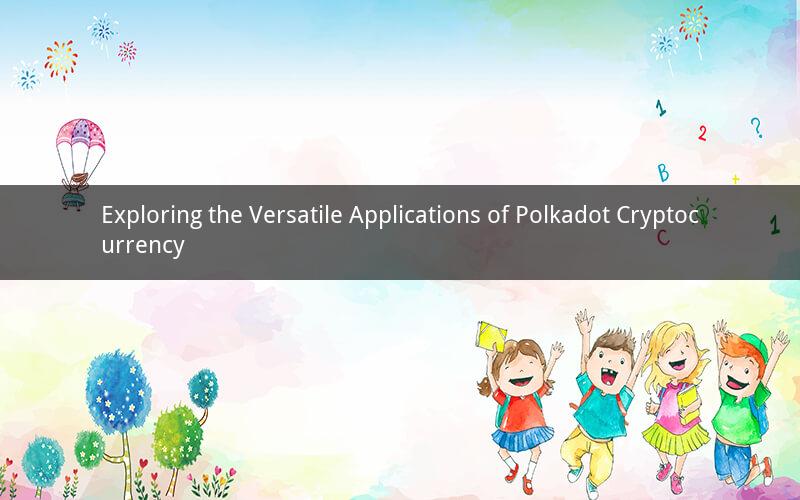
Polkadot, often referred to as "the internet of blockchains," has garnered significant attention in the cryptocurrency space. With its unique architecture and cross-chain interoperability capabilities, Polkadot offers a wide array of uses beyond just a digital asset. This article delves into the various applications of Polkadot cryptocurrency.
1. Decentralized Finance (DeFi)
One of the primary uses of Polkadot is in the realm of decentralized finance (DeFi). DeFi leverages blockchain technology to offer financial services without the need for intermediaries like banks or brokers. Polkadot's cross-chain interoperability enables the seamless integration of different blockchains, fostering a more open and inclusive DeFi ecosystem.
Polkadot facilitates DeFi applications by allowing developers to build decentralized exchanges, lending platforms, and other financial services that can operate across multiple blockchains. Its innovative parachain model allows for the creation of customized blockchains that can be integrated into the Polkadot ecosystem, further enhancing the diversity and functionality of DeFi applications.
2. Cross-Chain Interoperability
Cross-chain interoperability is a crucial aspect of Polkadot's architecture. Polkadot enables the seamless transfer of assets, data, and value between different blockchains, fostering a more interconnected and efficient global financial system.
The use of Polkadot in cross-chain interoperability includes:
- Asset Transfer: Polkadot allows for the transfer of digital assets across different blockchains, enabling users to exchange cryptocurrencies and tokens with ease.
- Data Sharing: Polkadot enables the secure and efficient sharing of data between blockchains, facilitating greater transparency and trust in the ecosystem.
- Value Transfer: Polkadot provides a scalable and efficient solution for transferring value across different blockchains, making it easier for users to access and utilize financial services.
3. Scalability and Performance
Polkadot's innovative architecture addresses the scalability challenges faced by traditional blockchains. The parachain model allows for parallel processing, significantly improving the transaction throughput and reducing network congestion.
Scalability and performance benefits of Polkadot include:
- Enhanced Transaction Speed: Polkadot's parachain model allows for higher transaction throughput, leading to faster and more efficient transactions.
- Reduced Network Congestion: By parallelizing transactions across different parachains, Polkadot minimizes network congestion, leading to a more sustainable and scalable ecosystem.
- Improved User Experience: Faster transactions and reduced network congestion contribute to a better overall user experience for Polkadot-based applications.
4. Governance and Community Involvement
Polkadot places a strong emphasis on community-driven governance, allowing stakeholders to participate in the decision-making process. The token holders of Polkadot can vote on key decisions, including the addition of new parachains to the network.
Applications of Polkadot in governance and community involvement include:
- Community Voting: Token holders can vote on important decisions affecting the Polkadot network, ensuring a decentralized and transparent governance model.
- Parachain Selection: The community plays a vital role in selecting new parachains, contributing to the growth and development of the Polkadot ecosystem.
- Collaborative Development: Polkadot fosters collaboration between developers, allowing for the continuous improvement and innovation of the network.
5. Smart Contracts and DApps
Polkadot supports the development of decentralized applications (DApps) through its smart contract capabilities. Developers can build DApps on Polkadot that offer a wide range of functionalities, from decentralized exchanges to identity management solutions.
Smart contracts and DApps built on Polkadot include:
- Decentralized Exchanges: Polkadot enables the creation of decentralized exchanges that offer secure, transparent, and user-friendly trading experiences.
- Identity Management: Polkadot-based DApps can provide users with decentralized identity solutions, allowing for greater privacy and control over personal information.
- Supply Chain Management: Polkadot's cross-chain interoperability and scalability make it an ideal platform for developing decentralized supply chain management solutions.
Frequently Asked Questions
1. What is the primary purpose of Polkadot cryptocurrency?
Answer: Polkadot is a cryptocurrency designed to facilitate cross-chain interoperability, scalability, and decentralized governance, with a focus on creating a more interconnected and efficient global financial system.
2. Can Polkadot be used for DeFi applications?
Answer: Yes, Polkadot is highly suitable for DeFi applications due to its cross-chain interoperability, scalability, and support for smart contracts. This enables developers to build decentralized exchanges, lending platforms, and other financial services on the Polkadot network.
3. How does Polkadot address scalability challenges?
Answer: Polkadot's innovative parachain model allows for parallel processing, significantly improving the transaction throughput and reducing network congestion. This results in enhanced scalability and a more efficient network.
4. What role does the community play in Polkadot's governance?
Answer: The Polkadot community plays a crucial role in governance through community voting and parachain selection. Token holders can vote on important decisions, ensuring a decentralized and transparent governance model.
5. Can Polkadot be used to develop decentralized applications (DApps)?
Answer: Yes, Polkadot supports the development of DApps through its smart contract capabilities. Developers can build a wide range of applications, including decentralized exchanges, identity management solutions, and supply chain management systems on the Polkadot network.